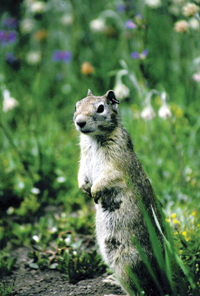|
||
      |
March of the ground squirrels

Less urgent warning calls prompt squirrels to stand and watch for predators.
Emerging from underground and surveying—for the first time—the bunchgrass meadow,sagebrush outcrops, and giant wild rye beyond their burrows, Belding’s ground-squirrel pups get pretty stressed out. Only 25 days old, they’re food for almost every predator within range (including cannibals among their own species), and in the next ten weeks they must eat enough leaves, seeds, and grasshoppers to see them through an eight-month hibernation. The pups leave the nest in late June. By the end of September, when snowfall prompts them to hibernate, raptors, snakes, coyotes, and a host of other hazards will have thinned their numbers by more than half. Sixty percent of the survivors will starve or freeze that first winter.
“I can mark 200 kids one year, and I’ll be lucky if I see five of them the next year,” says Jill Mateo, an animal behaviorist in the Institute for Mind and Biology and the Department of Comparative Human Development, who spends her summers studying Belding’s ground squirrels in California’s High Sierra Mountains.
What Mateo wants to know is this: just how stressed are the young squirrels, and how much does that pressure sharpen their survival skills? “When the kids first come above ground, their stress hormones”—specifically cortisol—“are elevated, generally twice as high as in the second or third week” above ground, she explains. “Cortisol mobilizes the energy to get them out of the nest and start them feeding.”
And, Mateo believes, cortisol also hastens pups’ understanding of essential early lessons: “They’ve got a lot to figure out in the first few days,” she says. “How to find food, where mom’s territory is, who’s the mean lady next door, which animals are predators—and, of course, alarm calls.” Youngsters must learn to dive for their burrows when they hear fellow squirrels’ high-pitched whistle, signaling a winged predator’s swooping approach. Staccato trills, meanwhile, warn of earthbound hunters. A less urgent alarm, it prompts other squirrels to stand up and look around.
“One way they learn what to do is by watching mom,” Mateo says. “So at first I thought the learning was social.” Surging cortisol readings, however, sent her in search of a biological component: perhaps youngsters emerged from the nest with cortisol raised to help them absorb their mothers’ behavior.
First, though, Mateo needed to make certain the elevated hormone didn’t simply reflect stress from an unfamiliar and often unfriendly environment where predators regard each new crop of pups as “a bowl of potato chips.” After all, adult cortisol levels do indicate real danger. At perilous Lundy Canyon, where distant predators are difficult to see and alarm calls ring out frequently, day-to-day hormone readings for full-grown squirrels remain lower—and therefore leave room for sharp cortisol jolts—than at Rock Creek Canyon and Mono County Park, both relatively safe areas. To assess whether hazards influenced youngsters’ stress hormones, Mateo sampled their cortisol levels at several sites. Her measurements came back strikingly uniform. During their first week out of the nest, pups at Rock Creek Canyon and Mono County Park posted the same cortisol levels as those at Lundy Canyon. “You don’t see significant population differences in corticoid levels” from one location to another, she says, until juveniles have been above ground for a few weeks and learned all the skills their mothers have to teach. Cortisol levels then begin to drop, and by two months settle to adult levels, spiking and sinking with the shifting danger.
Young squirrels’ hormones, though, hold steady even in the presence of predators. At first this seemed counterintuitive: sharp rises in cortisol help squirrels respond more quickly to threats. But perhaps, Mateo hypothesized, cortisol stays at an ideal level- during those first weeks because extremely high levels of the hormone would hamper learning. “We know from the lab that in captive animals,” Mateo says, extremely high or low cortisol levels impair learning. “Moderate stress can actually help. But nobody’s shown in free-living, outbred animals that cortisol helps or hurts learning.”
To test those laboratory results in the wild, Mateo set up a series of experiments using squirrels just out of the nest in a large outdoor enclosure meant to mimic their natural habitat. First she spiked one group’s drinking water with enough cortisol to raise its level fourfold. Mateo calculates cortisol fecally, by extracting metabolites from “dried and powdered poop.” Less likely to raise the animals’ stress hormones than trapping, handling, and drawing fluids, fecal measurements also summarize cortisol levels over 24 hours, rather than a single instant. Menacing the pups with alarm calls and a flying Frisbee that “scares the bejesus out of them,” Mateo found those with artificially high hormones had trouble remembering what to do. After pairing the Frisbee with a blackbird alarm call once, the next day Mateo played back only the alarm call. Every squirrel with untreated drinking water ran for its burrow. But only 55 percent of the cortisol group responded, and most wrongly, by standing instead of fleeing.
“These findings are completely new,” Mateo says, adding that the research may offer insights that reach beyond Belding’s ground squirrels’ High Sierra meadows. “The analogy I see is with human kids growing up in stressful environments,” she says. “What are their stress levels doing, and how does that affect them? Should we be sprinkling cort on kids’ cornflakes” because a moderate hormonal spike seems to aid learning? “Probably not, but it’s something to study.” Mateo reckons she probably will study it—someday. Right now, however, the squirrels are hibernating again, and when they come out of their burrows Mateo will be there. “I’m wondering,” she says, “the kids act like mom and they have mom’s cort levels, but which comes first?” She’s planning to swap a few litters and mothers to find out.